
- A statue of this great Saint Soldier
seen against the backdrop of
the fort of Raigad,
which was his capital
|
- Chattrapati Shivaji Maharaj and the National Revival under the Marathas
_____________________
_____________________________________________________________________________________________________________________________
The Marathas - Samurais from Western India
The Marathas are a proud and hardy race who are a sub-set of the wider Hindu Community. They are first mentioned in Indian history as the stout fighters in the army of the Chalukya King Pulikeshin who resisted the Southward march of Emperor Harsha in the 7th century C.E.
 | CHATTRAPATI SHRI SHIVAJI MAHARAJ - A statue of this great Saint Soldier seen against the backdrop of the fort of Raigad, which was his capital |
The Maratha dynasties of the ancient (pre-Muslim) period are the Chalukyas (500 C.E. to 750C.E.), the Rastrakutas (750 C.E. to 978 C.E. and the Yadavas or Jadhavs (1175 C.E. to 1318 C.E.).
The Marathas were the first who crossed Malik Kafur's path, when he invaded the deccan in 1314 C.E. They were then led by the last scion of the Yadava dynasty - Ramdev Rai Yadava who ruled from Devagiri (today's Daulatabad). In their first clash with the Muslims; the Marathas lost to the invaders and accepted the status of being vassals and mercenaries of their Muslim overlords.
The Marathas before Shivaji were Mercenaries and revenue Collectors for the Muslim Rulers
In keeping with the feudal tradition, the Maratha Sardars (Generals), before Shivaji kept shifting their loyalties from one Muslim ruler to another. And there were many Muslim rulers like the Adilshahis at Bijapur, the Nizamshahis at Ahmednagar (Berar), the Qutubshahis at Golkonda (Hyderabad), etc.
Shahji Bhosale, who was Shivaji's father typified this practice of shifting loyalties from one Muslim overlord to another. He was from time-to-time in the service of the Mughals, the Adilshahis and the Nizamshahis. The thought of establishing an independent Maratha-Hindu kingdom, does seem to have crossed his mind, but he never really got about to doing it successfully. The germ of this idea however seems to have got rubbed into Shivaji - his son by Jijabai.
Shivaji Maharaj - the Visionary Saint-Soldier
Shivaji was born in the year 1627 at the Fort of Shivneri in Maharashtra in Western India.
 | SHIVNERI FORT - The birthplace of Shivaji Maharaj On the crest of the hill at the center of this photo is Shivneri fort. |
Shivaji's mother, Jijabai was a direct descendant of the erstwhile Yadav royal family of Devagiri. She seems to have nursed deep within her mind the idea of recovering independence from Muslim rule which her Yadav forebears had lost in the year 1318. Shivaji grew up with these ideas embedded into him. His childhood stories are those of playing games in which he and his friends attacked and captured forts held by the enemy.
The Oath of Independence - at Raireshwar
When Shivaji was seventeen, he decided to transform what were till then simply games to a reality. He and his friends encouraged by Jijabai and his Guru Dadoji Kondeo; decided to take a formal oath to free the country from the shackles of Muslim tyranny. This was done in the year 1645 in a dark cavern housing a small temple to the Hindu God Shiva (locally called Raireshwar).
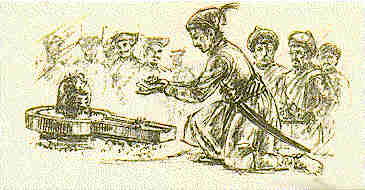 | At the cave temple of Raireshwar in the Sayhadris Shivaji and his select band of teenaged Maratha friends slit their thumbs and poured the blood oozing from it on the Shiva-linga (Phallus representing the Lord Shiva). By this act they declared a blood-feud against Mughal tyranny. |
Here Shivaji and his select band of teenaged Maratha friends slit their thumbs and poured the blood oozing from it on the Shiva-linga (Phallus representing the Lord Shiva). By this act they declared a blood-feud against Mughal tyranny. This was the beginning of a long and arduous Maratha-Mughal struggle that went on for the next century and a half to culminate in the defeat of the Mughals and their replacement by the Marathas as the dominant power in India when the British came into the scene. (But more of the British later.)
Shivaji's encounter with Afzal Khan
When Shivaji started his military career by capturing the fortress of Torana, it sent shockwaves in the Adilshshi court at Bijapur. Here was a local Hindu chieftain, daring to challenge the might of a Muslim ruler. The retribution was swift and Adil Shah sent in his most fearsome general named Afzal Khan to bring back Shivaji dead or alive to Bijapur. Afzal Khan who was reputed to be more than six feet tall and of a real massive built, set on his mission and in order to lure Shivaji down into the plains, he destroyed the Hindu temples at Tuljapur, Pandharpur and Shikhar Shenganapur.
Afzal Goes Up to Pratapgad
This ploy failed to work and Shivaji stuck to his Hill fastness in the Sahyadris. Shivaji even sent a letter to Afzal Khan praising the legendary strength of Afzal Khan's powerful arms and his reputed fearlessness. Shivaji addressed him as his uncle and said that he was afraid to come down to meet Afzal Khan. Shivaji asked him to come up into the hills to meet him and on condition that Afzal Khan came with not more than few select soldiers. The proud Khan felt that the Dekkhan-Ka-Chuha (Rat of the Deccan as the Muslims scornfully addressed Shivaji) had really chickened out.
Afzal Meets his Nemesis in Shivaji
Khan-Saheb agreed to go up the hills at Pratapgad to meet his nemesis. When the meeting took place, Afzal Khan embraced Shivaji and with his diminutive enemy (Shivaji was less than five feet in height) in his grip, Afzal suddenly pulled out his dagger and tried to stab Shivaji. When Afzal's dagger could not plunge into Shivaji Maharaj due to the protective armour which Shivaji was wearing, Afzal tried to throttle him. But the wily Maratha was more than prepared for this as he had come down not only with full armour that was hidden by his thick satin robes, but he also had with him the 'Wagh Nakh' - a sharp weapon resembling tiger claws that could be hidden in the grip of one's fist. In addition, he had the Bichhwa - curved dagger hidden in the pocket of his waistcoat.
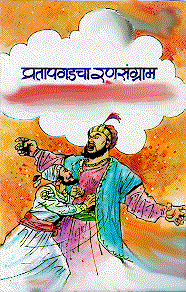 | Shivaji Maharaj thrusts the Wagh-Nakh into Afzal's Abdomen when Afzal tried to stab and then throttle Shivaji Maharaj. Shivaji Maharaj emerged the victor in this battle of muscles and wits. |
Jiwa Mahalaya
On sensing that the Khan meant to throttle him, Shivaji pierced the tiger claws deep into Khan's belly and pulled out his intestines. After which Shivaji repeatedly stabbed him with the bichhwa. The Khan bellowed "Daga" "Daga" and yelled for Syed Banda, his bodyguard to come to his rescue. When Syed Banda, also a burly Muslim was about to strike Shivaji with his sword, Shivaji's bodyguard Jiva Mahalya struck off Banda's upraised arm in the air itself.
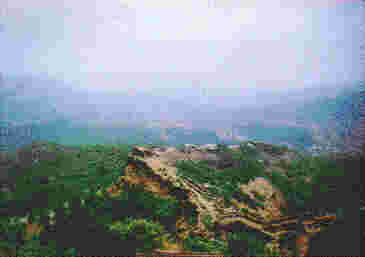 | PRATAPGAD FORT This fort was named after the "Pratap" (Act of Valour) of Shivaji Maharaj in slaying his assailant |
Santaji Kawji
After this commotion, the bleeding Khan tried to make good his escape and rushed into his palanquin. As the palanquin bearers set off with the fleeing Khan, Santaji Kawji, another of Shivaji's select warriors cut-off the feet of the bearers and Khans' palanquin, with its load of Khansaab fell to the ground. Santaji Kawji, then finished off the task of sending Khan to his final resting place. Khan's army which was waiting in the valley was ruthlessly massacred by the Marathas who were hiding behind every crevice and bush in the densely wooded jungles around the Pratapgad fort. At the place where this encounter took place on 10th November 1659 between Shivaji Maharaj and the Khan, there stands today a Kabar (grave) erected by Shivaji for the departed Khan's soul to rest in peace.
Bijapur Stymied
The result of this dramatic encounter was that the Bijapur ruler panicked and after that never posed a serious threat to the growing Maratha power. The next Muslim power which Shivaji turned to was that of the Mughals. Here was the real challenge for Shivaji. The Bijapur rulers were a provincial power, while the Mughals were an power of imperial dimensions whose writ ran almost all over Northern India.
The Siege of Panhalgad
Despite this defeat, Bijapur's Adil Shah made one last attempt to check Shivaji by sending another general named Siddhi Jouhar against him. Siddhi besiged Panhalgad where Shivaji was camping. The seige went on for some months, from summer till the monsoons. But Shivaji Maharaj slipped out of Panhalgad and reached safely at Vishalgad.
The Brave Deed of Baji Prabhu Deshpande
It is during this escape that Baji Prabhu Deshpande held the pursuing enemy troops at a narrow pass called Ghod Khind. Baji Prabhu immortalized himself by laying down his life but ensured that his Master reached safely at Vishalgad. This narrow pass is today known as Pawan Khind i.e. a Holy Pass. Made holy by Baji Prabhu's memorably brave deed.
Encounter with Shaista Khan - Aurangzeb's Uncle
The next Khan to come down 'literally' before Shivaji was Shaista Khan. On hearing Shivaji's depredations, Aurangzeb was furious and wanted to desperately crush this infidel upstart. He sent his uncle maternal Shaista Khan with a large and powerful army to checkmate Shivaji.
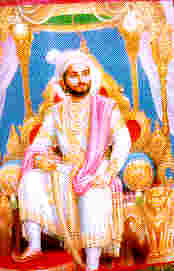 | SHIVAJI MAHARAJ He set an example of religious tolerance in an age when conversion at the point of the sword was the norm. He defended the honour of womenfolk in an age when captured women of the enemy were considered to be the rightful property by their Muslim captors to be put in the Haram - concubine chamber. Shivaji Maharaj was way ahead of his times in his vision and mission. |
But even this time the wily Maratha proved that brain was stronger than the brawn.
Shaista Khan came into Maharashtra and started devstating towns, villages fields, temples, forts and everything that came in his path.
Shaista Establishes his Harem in Shivaji's Devghar (Prayer Room)
To provoke Shivaji, Shaista Khan established his camp in Shivaji's home in Pune called Lal-Mahal. And to top it up, he put up his Harem in Shivaji's Devghar (prayer room).
Shaista is Lucky - He Only Loses His Fingers
Shivaji bided his time for many months and one on fine day (night), he with a select band of Maratha Samurais, sneaked into Pune and into the Lal-Mahal. He tracked down the sleeping Khan to his bed. The Khan sensing that his time was up tried jumping out of the window. At that point Shivaji cut off the Khan's fingers with which he was holding on to the window sill.
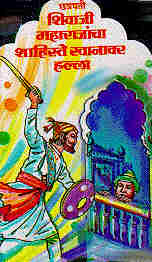 | For all his belligerence, Shaista Khan proved to be a coward when he faced Shivaji Maharaj in person. The Khan, who was Aurang's (the Mughal Emperor) uncle miserably tried to jump out of the window when Shivaji Maharaj came for him! |
On the Khan's wife's pleading before Shivaji to spare her husband's life as she considered Shivaji to be her brother. And so killing her husband would mean making her a widow, Shivaji spared the Khan's life. This was a mistake for which Shivaji was to pay dearly later. Shivaji made good his escape from the Khan's lair, but not before the treacherous Khan ordered his troops to give chase and try to capture the fleeing Shivaji.
Shaista's Retreat from Maharashtra
The Khan however, decided that enough was enough and returned to Delhi - without his fingers. This happened in April 1663
The failure of his uncle peeved Aurang to no end and he now sent another general to subjugate Shivaji. This was Mirza Raja Jai Singh, Aurangzeb's Hindu general who was also the scion of the house of the Suryavanshi Kachhawaha's who we saw earlier had ingratiated themselves to the Mughal rulers by giving away their daughters in marriage to the Mughal Padishah. (The Moghuls incidentally never returned the favour by giving, or even offerring, their daughters to the Rajputs!). This Mirza Raja Jaisingh who came with a powerful force was smarter than Shaista Khan sent earlier by Aurangzeb. Mirzaji laid siege to Purandar alongwith a systematic loot and destruction of rural Maharashtra.
The Brave Deed of Murar Baji
When Raja Jai Singh and his general Diler Khan laid siege to the Fort of Purandar. Murar Baji was the Maratha Fort Commandant at Purandar. To break the morale of the Maratha troops, Diler Khan launched a viscious attack on the fort and laid waste the surrounding countryside. The Mughals succeeded in forcing their way into the outer defenses of Purandar.
But the Marathas were not easily intimidated, they withdrew to the inner fort (bali-killa) and kept on their attack on the besieging Mughals. One day, Murar Baji decided to rain hell on the enemy and the Marathas stormed out of the fort and fell upon the Mughals who were occupying the outer fort. In face of the Maratha attack, the Mughals broke ranks and fled to their main camp in the plains below, where Diler Khan was camping.
 | The Fort of Raigad was the capital of Shivaji Maharaj. His coronation ceremony took place in this fort. The British and other foreign powers sent their repesentatives to that ceremony. |
Seeing the ferocity of the Maratha attack, Diler Khan, decided to tempt Murar Baji with an offer of making him a general in the Mughal army if he betrayed Shivaji. When news of this offer reached Murar Baji, in the midst of the battle, his rage knew no bounds, and in a rash act he pushed into the ranks of the Mughal troops, hacking right, left and center towards Diler Khan and shouted at him that he would reply Diler's offer by cutting off his head and taking it to Shivaji Maharaj.
Murar Baji had left his own troops behind and was now surrounded by Mughal troops on all sides, but he could only see Diler, whose head he wanted. This act was brave but rash and cost Murar Baji his life. Their leader dead, the Marathas withdrew into the fort. The news of this battle and the passing away of Murar Baji and the long drawn siege along with the destruction of the countryside forced Shivaji to reach out for a compromise with Jai Singh in the interests of the sufferring population of Maharashtra.
The Treaty of Purandar
The treaty of Purandar signed between Mirza Raja Jai Singh and Shivaji Maharaj had among many conditions, one condition that Shivaji accompany Mirzaji to Agra. Shivaji decided to go to Agra in 1666.
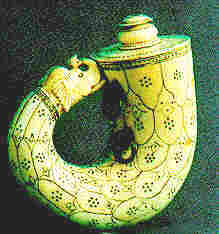 | A Maratha Gunpowder Keg. Shivaji Maharaj not only fought for independence, but strived to preserve it. He created a ministry of Military Affairs in his eight ministerial cabinet (Asta-Pradhan Mandal).His Minister of Warfare was Hambirrao Mohite. Shivaji Maharaj established factories at Raigad and at other important forts for the manufacture of guns and gunpowder. |
Shivaji's Visit to Aurangzeb at Agra
At Agra, when Shivaji presented himself at the Moghul court, Aurangzeb deliberately insulted him by making him stand behind a lesser noble whom Shivaji has once defeated in battle. This was a calculated humiliation that Aurang had arranged for Shivaji. As a result Shivaji left the court in a huff. This gave Aurangzeb an excuse to declare Shivaji of having committed the offence of insulting the Mughal court.
Imprisonment of Shivaji
Aurangzeb detained Shivaji in Mirza Raja Jai Singh's house where Shivaji had put up. Shivaji seems to have read Aurangzeb's mind of having him put to death. Aurag had made plans to shift Shivaji into the proper Mughal dungeons.
Shivaji's Escape from Aurang's Clutches
Shivaji struck upon an idea and said that he wanted to make peace with God by sending fruit and sweetmeats to Brahmins and holy men. To this Aurangzeb consented. One fine day Shivaji and his son Sambhaji hid himself in two of the sizable baskets in which fruits and sweetmeats had been packed everyday and made good their escape from Aurnag's custody. In doing this Shivaji must have had in mind what had happened to his general Netaji Palkar who after being captured by the Mughals had been forced to embrace Islam and change his name to Quli Mohammed Khan. Netaji was forced to serve as a Mughal soldier in Afghanistan, till he too made good his escape and returned to Shivaji to reconvert to Hinduism and join the forces of Swaraja once again. Others were not so lucky, they were made to convert to Islam and some others were simly tortured to death - as was to happen later with Shivaji's son Shambhu Raje or Sambhaji, ater Shivaji's death.
 | Shivaji Maharaj's Seal. Shivaji Maharaj was the first Hindu King to ascend a throne after a long time. During the Dark Days of Muslim Tyranny, Shivaji Maharaj was one of the very few (along with the Ranas of Mewad), to issue his own coinage. Shivaji's coinage was in Sanskrit. The coins were in two main denominations, the Shivrai made of copper was a lower denomination coin and the Hon was a gold coin of a higher denomination. To erase the memory of Shivaji Maharaj, Aurangzeb issued an order after the passing away of Shivaji Maharaj that all Hons were to be imponded and melted. That Aurang did not succeed in erazing Shivaji Maharaj's illustruous personality from our memory is another matter. |
Coronation of Shivaji as Chattrapati
After returning to the deccan, Shivaji again raised an army and recaptured all the forts that he had been made to surrender to the Mughals as per the treaty of Purandar. In this phase we see the exploits of his brave general Tanaji Malusare who perished while recapturing the invincible fort of Kondana from Uday Bhan - the renegade Rajput who was the Mughal commandant of the fort. After all the forts had been recaptured, Shivaji was pursuaded by Gaga Bhatt (a brahmin from Benaras) and his mother the ageing Jijabai to formally crown himself as the king of the Marathas. The coronation took place at Raigad on the 6th of June 1674.
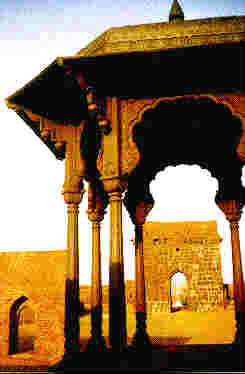 | THE ORIGINAL CHATTRI OF SHIVAJI MAHARAJ AT RAIGAD FORT This is the Coronation place of Shivaji Maharaj, from which we have the title Chattrapati. |
Narvir Tanaji's Impossibly Brave Deed
The fort of Kondana, which is today on the outskirts of Pune town was then an outpost overlooking Pune and the surrounding countryside. It was strategically placed in the center of a string of forts of Rajgad, Purandar, and Torna. The capture of Kondana was necessary if Shivaji Maharaj was to re-establish de facto control over the Pune region.
Recognizing the strategic importance of Kondana, the Mughals had maintained a battalion of 5000 troops led by Udai Bhan, a relative of Mirza Raja Jai Singh. The fort was built in such a way that all its approaches were covered by cannon-fire. Only on turret was not well defended as it was at the top of a vertical overhanging cliff.
Tanaji decided that this was the only way, he could enter the fort. He dressed himself as a Gondhali (devotee of the Goddess Bhavani of Tuljapur) and roamed the surrounding villages. He won the trust of one Mahadev Koli who was in the service of Udai Bhan. Koli presented the disguished Tanaji to Udai Bhan, who was suitably impressed by this "devotee" and allowed him free access to the fort.
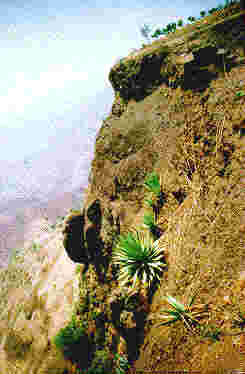 | THE GHORPAD CLIFF This is the sheer cliff that Tanaji and his brave Mavalas (comrades) scaled to surprise the Muslim army that was engrossed in a drunken orgy on the plateau seen at the top during a dark night in 1669. |
Tanaji carried out a careful surveillance of the fort and at that very night when he was told that at the overhanging cliff Udai Bhan and all his senior commanders would be celebrating a usual party with an alcohol and dance orgy; Tanaji decided that he should seize this opportunity.
With almost all his troops, Udai Bhan had a roaring party on top of the overhanging cliff. Unknown to them after midnight, Tanaji and his brave followers who numbered 300 scaled the cliff using ropes tied to a reptile called Ghorpad. The Ghorpad can stick fast to any surface and a number of adults can use this force to scale a vertical cliff with the help of a rope, one end of which is tied to the Ghorpad. Silently Tanaji and his comrades slunk up to the top of the cliff.
On the other side his uncle Shelar Mama and his brother Suryaji had moved close to the other gates of the forts with another 300 Mavalas (Maratha Soldiers). On a signal from Tanaji, all his comrades who has taken up strategic position all round the celebrating Mughal army, broke into the party and mercilessly fell upon their enemies. They started slaughtering the surprised and ill-prepared and drunken Muslim soldiers.
When Udai Bhan saw that Tanaji - the leader of this invading band of Marathas was no other than the devotee whom he had given permission to visit the fort, he flew into a mad rage. On seeing Tanaji, Udai Bhan rushed at him and we are told that for a few fatal seconds, Tanaji started dancing in the same fashion as he had done as a Gondhali (devotee) when he had met Udai Bhan earlier in the day. The enraged Udai Bhan lunged at dancing Tanaji and cut off the arm with which Tanaji was holding his shield. But undaunted Tanaji used his turban to ward off further thrusts from the blade of Udai Bhan's sword and continued fighting him for 2 hours in this state with his wristless left arm bleeding profusely. It is for this feat of Tanaji, that he is called Narvir - Brave amongst Men.At the end of this ordeal, the exhausted Tanaji fell to a fatal swish of Udai Bhan's sword. But Udai Bhan too was throttled by Shelar Mama and thus lost his life.
 | NARVIR TANAJI's CHATTRI (MONUMENT) This is the Monument erected at Simhagad by Shivaji Maharaj in memory of a brave soldier who laid down his life for National Independence. On this event Shivaji Maharaj is said to have said on this occasion "Gad aala, paan Simha gela" (We have won the fort but have lost the Lion - Tanaji). The fort of Kondana was renamed as "Sinhagad" in honour of Tanaji's brave deed. |
Shivaji Maharaj is said to have said on this occasion "Gad aala, paan Simha gela" (We have won the fort but have lost the Lion - Tanaji). The fort of Kondana was renamed as "Sinhagad" in honour of Tanaji's brave deed.
A "Nazarana" - The Daughter-in-law of the Muslim Subahdar of Kalyan
During the days after the coronation, many Maratha generals presented Nazaranas (tribute in kind) to the newly anointed King of Maharashtra. It was then a practice of the Muslims to abduct any fair maiden and to force her into the harem as a concubine. (A harem is a term for the living quarters of abducted women, nominally treated as wives.) On one such occasion, following the "illustrious" example set by the Muslim aggressors, a Maratha Sardar also (general) abducted a daughter-in-law of the Muslim Subahadar of Kalyan, near Mumbai (Kalyan was then under Mughal occupation).
 | THE TEMPLE OF KHANDOBA AT JEJURI This was one of the many temples that had been destroyed and converted into a Mosque by the Muslim aggressors Shivaji Maharaj reconverted it into a temple. Even today, the temple structure displays a mix of Hindu and Muslim architecture. But in spite of the trying circumstances of religious bigotry of the Muslim aggressors in which he operated, Shivaji Maharaj never disrespected the Muslim faith. Whenever a copy of the holy Koran fell into the hands of Maratha troops, Shivaji Maharaj had given strict instructions to treat it with utmost respect and hand it over to the local Maulavis (Muslim priests). |
This Sardar presented this "Nazarana" to Shivaji Maharaj, expecting to be patted on the back for such a "fair" tribute. Shivaji Maharaj's reaction at this occasion, gives us an insight into the mind of the person who lived 300 years before us. Shivaji not only chided the general, but warned him and all the other Maratha generals that such a heinous offence would henceforth attract a penalty of the offender's hands being chopped off. The dazed general was asked by Shivaji to return with full honours, the daughter-in-law of the Muslim Subahadar of Kalyan.
The Maratha ballads (Povadas) that describe this event say that on hearing Shivaji's dialogue in Marathi the teenaged girl is said to have exclaimed "Ya Allah, yeh aadmi nahin farishta hai. Ees farishtey pe kamyaabi bahal karna." ("O Lord, this is not an ordinary man but an angel. Bestow success on this angel.") The Maratha balladeers, while narrating this event say that "Asseech amuchi aai asatee,sundar roopavati; amhi hee sundar zhalo asato - vadaley Chattrapati" ("If my mother had been as beautiful, I too would have been as beautiful - exclaimed Chattrapati"). These dialogues might as well be a later romanticization of what actually happened. But it proves a point - Shivaji Maharaj had risen above the attitudes of religious bigotry, and beastly behaviour that had come to typify the Indian ruling class under Muslim rule.
Karnataka and Tamil Nadu Campaigns of Shivaji
After this Shivaji launched his campaign in Karnatak, which took him up to Thanjavur in Tamil Nadu. The period from 1674 up his passing away in 1680 was a relatively peaceful period, as the Mughal made no more attempts to molest the Marathas. Only after the passing away of Shivaji Maharaj did Aurang again dared to venture into Maharashtra, and then too he did not entrust the task to any general. He came himself in 1682 and stayed on in the deccan till his death in 1707.
The Marathas After Shivaji Maharaj - Sambhaji
After the passing away of their illustrious leader, the marathas fell into relative disarray. Shivaji's eldest son Sambhaji did not prove adequate to the responsibility of preserving the flame of independence to which his father had given the initial spark. Sambhaji was extremely fearless and brave. Maratha chronicles (Bakhars) refer to him as in fact more assertive and independent than his father. But in addition to all this Sambhaji also had vices like wine and women. In his eventful life, Shivaji Maharaj did not seem to have had enough time to groom his successor. Sambhaji's temper had a short fuse. During Shivaji's life-time itself, he had once quarreled with his father and had gone over to join the Mughals as one of their Mansabdars. Subsequently, he realized his folly and came back to his father and repented. But this act of his deeply hurt his father nad also displayed his chimerical nature for which he was to pay later with a painful death.
 | Another view of the Khandoba Temple at Jejuri - Khandoba, the deity at Jejuri is the fighter God of the Marathas. He is shown astride a horse and has a angry warlike look. This was reason enough for the Muslims to repeatedly destroy the temple. Even Aurangzeb attempted to destroy the temple a second time in 1690. He however was thwarted in this attempt when a nest of hornets was disturbed by the Mughal soldiers while trying to attack the temple. The hornets so harrassed the besieging Mughal soldiers that Aurangzeb was forced to lift the siege and spare the temple. The Bigoted but God-fearing Aurangzeb is said to have placated the angry bees by offerring One Hundred and Twenty Five Thousand Silver Coins to the God Khandoba. Even today this place is known as Sava Lakhacha Bhunga. |
After the death of Shivaji Maharaj, Sambhaji was crowned as Chattrapati. He brazenly followed policies detrimental to the fledgling Maratha power. In this he was given short-sighted advise by his friend Kavi Kalash.
Sambhaji's Assassination
Sambhaji did not falter in battling the Mughals, as well as the Portuguese. In those days Aurnagzeb had come over to the Deccan. After subjugating the Bijapur and Golkonda kingdoms, he turned his attention on the Marathas. He carried on a ceaseless campaign against the Marathas. Sambhaji performed many daring acts in this guerrilla campaign especially in the Konkan region. But in spite of his bravery, his short temper and his vices went against him. One night, when he was passing thru Sangmeshwar with a small band of bodygaurds, he was waylaid by the Mughals and was brought in chains before Aurangzeb.
On being presented to Aurabgzeb, Sambhaji was asked to surrender all his forts, accept Islam and enter the service of the Mughal Emperor. To this affront, Sambhaji scronfully replied that he could consider this if Aurangzeb gave him his daughter in marriage and proclaimed him as the successor to the Mughal throne! On hearing this Aurang flew into a rage and decided to torture Sambhaji to death. Sambhaji's eyes were gouged, his tongue was cut off, followed by his arms and legs. Sambhaji died an inhuman death, but till the agonizing end he never recanted his faith.
Rajaram, Tarabai and Shahu
After Sambhaji's assassination, his step-brother Rajaram became the king. He was not especially brave and is said to have been physically weak. During his time Aurangzeb besieged and captured Raigad. Instead of fighting the enemy, Rajaram fled from Raigad when the fort was about to be besieged. Raigad fell into the hands of the Mughals in 1689 when a renegade Maratha called Suryaji Pisal betrayed the defences of the fort to the besieging Mughals. During the capture of Raigad, Sambhaji' wife Yesubai and his son Shahu were taken captive by the Mughals. Rajaram's life as Chattrapati was spent mostly in fleeing from the Mughal armies. Nevertheless during his times, the generals like Santaji Ghorpade and Dhanaji Jadhav carried out a whirlwind guerrilla campaign to harras the Mughal army and never let Aurangzeb rest in one place. Thus in spite of his presence in the Deccan for more than 25 years from 1680 to 1707, Aurang could not subsume the flame of independence lit by Shivaji Maharaj.
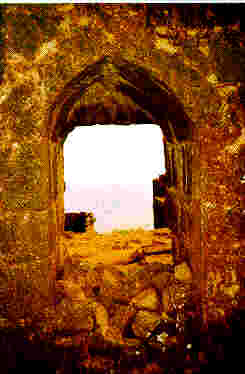 | A View from the Turrets of Raigad Fort This fort was invincible. After the passing away of Shivaji Maharaj in 1680, the fort could be captured by Aurangzeb in 1689 only when Suryaji Pisal - a renegade Maratha, betrayed the defenders and opened the doors secretly to let the enemy troops inside at night. |
In 1700, Rajaram died of sickness and he was succeeded by his wife Tarabai. She was the nominal leader of the Marathas from 1700 to 1707, although the military activities were coordinated by the duo of Santaji and Dhanaji.
Aurang's Death in 1707
When Aurang died in 1707, his son Azamshah who was with him at his deathbed, proclaimed himself the Mughal Emperor and prepared to battle his elder brother Muaazam, who was then in Kabul. To ensure that the Marathas came over to his side, Azamshah released Shahu who was till then held as a prisoner by the Mughals. Shahu had been a prisoner for 18 years from 1689 up to 1707. When Shahu staked his claim to the throne, Tarabi was ruling. A battle between the two was inevitable. This battle fought at Khed went in favour of Shahu and he became the Chattrapati. He was incidentally the last de facto Chattrapati of the Marathas.
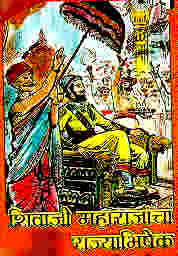 | The Coronation of Shivaji Maharaj marked the zenith of a career full of daring acts of personal bravery of this unique personality. |
Prime Ministers Peshwas become de facto Kings
During the days of Shahu, his general Dhanaji Jadhav had a very able accountant named Balaji Vishwanath Bhatt. This accountant rose in Dhanaji's favour by dint of hard work. His successful track record brought him visibility in the eyes of Shahu.
On Dhanaji's passing away, Shahu appointed him as his accountant. During this period, Shahu was attacked by forces loyal to Tarabai. To face this attack, Shahu appointed Balaji Viswanath Bhatt as a Senakarta (i.e. Commander). Balaji Viswanath proved to be an able soldier too. This increased the confidence Shahu had in him and he appointed Balaji Viswanath as his representative to negotiate with Kanhoji Angre, the Admiral of the Maratha Navy, who was at that time with Shahu's rival Tarabai. Before, balaji Viswanath could take up this assignment, he asked Shahu to appoint him as a Prime Minister or Peshwa. To this request Shahu conceded and Balaji Vishwanath Bhatt became the Chattrapati's first Peshwa.
Balaji negotiated with Kanhoji Angre and both consented to accept the other's independent sphere of influence. With Balaji Vishwanath in charge of the Maratha military and Kanhoji in charge of the Marathas Navy. This agreement set the course for Balaji Viswanatha's rise as a Peshwa during his subsequent visit to Delhi with an army of 12,000 Marathas. During this visit to Delhi, on an invitation from the Syed brothers in their struggle with the Mughal Emperor Farrukhsiyyar, the Maratha forces led by Balaji Viswanath clashed with the forces of Mughal Emperor and defeated them. This was the first Maratha victory over the Mughals in Delhi. This event marks the asendency of the Marathas in Delhi an asendency that was to last for almost a century till they were supplanted by the British in 1803.
The Peshwas - Baji Rao, Balaji Baji Rao, Madhav Rao
As we saw above, after Shahu, the de facto executive power passed into the hands of the hereditary Prime Ministers the Peshwas. Balaji Viawanath Bhatt was succeeded by his son Baji Rao the first. Baji Rao was a very able and ambitious soldier and he was the one who consolidated Maratha power in North India.
 | The Spread of the Maratha Empire. The Marathas rose to the status of Imperial Rulers of India. Their rise from freedom fighters for swarajya to the rulers of Marathi Daulat (Empire) took place from 1720 to 1761 and lasted till 1803 when they were supplanted by the British. |
Baji Rao died at a relativey young age of 40 in the year 1740. His was succeeded by his son Balaji Baji Rao. Balaji Baji Rao played a tragic role in Maratha history and the fissiparous tendencies he let loose ultimately let to the downfall of the Maratha empire.
His first mistake was to go back on the agreement between his grandfather Balaji Viswanath Bhatt and Kanhoji Angre according to which the Peshwa was to have no direct control over the Maratha Navy. He attacked the his own navy and weakened one arm of the Maratha might.
During his rule, North India was invaded by Ahmed Shah Abdali first in 1756. Balaji Baji Rao then sent his brother Raghunath Rao along with Malharrao Holkar to defeat Abdali. Raghunath rao not only defeated Abdali but chased him up to the Khyber pass till Attock in Paktoonistan. .
This success of Raghunath Rao aroused the jealousy of Balaji Baji Rao's wife Gopikabai, who started conspiring against Raghunath Rao to undermine his influence. This led to corresponding jealousy from Anandibai who was Ragunath Rao's wife. The unfortunate fallout of this court intrigue ws to end in the disastrous 3rd battle of Panipat in 1761.Let us see the event that led to this catastrophe at Panipat.
 | A Mavla Maratha soldiers were known as Mavlas Among them were valiant warriors like Tanaji Malusare, Murar Baji, Santaji Ghorpade, Baji Prabhu Deshpande, and many others. Known for their daring bravey it was they who helped Shivaji Maharaj lay the foundations of Hindavi Swaraj and of the Maratha Empire in face of brutal Muslim Tyranny. But when the Marathas gave up their guerrilla tactics under haughty and over-confident leaders, the result was PANIPAT |
The Persian Invasion of 1740 by Nadir Shah
Some 80 years after Shivaji when the Mughal Empire had been weakened by repeated Maratha attacks, the Afghan raider Ahmed Shah Durrani (Abdali) invaded North India. As the Mughals were past their prime and were now living at the mercy of the Marathas, they did not dare oppose Ahmed Shah. The task of challenging him was left to the Marathas. The Marathas who then were on their ascendancy in North India had since the first Persian-Afghan invasion by Nadir Shah, the king of Persia in 1740, established themselves as a dominant power in Northern India. The 20 years from 1740 to 1760 saw a see-saw battle between the Afghans and the Marathas for the domination of North India.
With the defeat of Mohammed Shah, the Moghul Emperor in 1740 by Nadir Shah (in whose army Ahmed Shah Abdali was a general), the Mughal power steadily declined and its place was usurped by the Rohillas who were led by an ambitious and ruthless chieftain named Najib Khan. Najib's ambition was to supplant the Moghal Emperor and crown himself as the ruler of India by capturing Delhi.
The Marathas Liberate Punjab
But the growing power of the Marathas in their northward expansion, stood between Najib and his ambition. To overcome the Marathas, in 1755, Najib invited Ahmed Shah Abdali from Afghanistan to help him in defeating the Marathas and crown himself the ruler of India. In this, he was thwarted by the Marathas who decisively defeated the Rohillas and Afghans near Delhi in 1756. The defeat was so decisive that Najib Khan surrendered to the Marathas and became their prisoner. The Maratha forces were led by Shrimant Raghunath Rao and Malhar Rao Holkar.
After defeating the Afghan-Rohilla forces, the Marathas pursued the Afghans into the Punjab and beyond up to the Khyber pass. The last frontier of the Marathas was at Attock in today's NWFP (or Paktoonistan) on the Afghan border. (This campaign of the Marathas led by Shrimant Raghunath Rao is called as Raghu's Bharari - i.e. whirlwind campaign.
Thus after nearly 800 after the last Punjabi King Tirlochan Pal Shahi had been defeated by Mahmud of Ghazni in 1020 C.E. did that part of India come under Indian rule in 1756 due to the liberation of Punjab by the Marathas.
 | The Dawn of SwarajyaShivaji Maharaj gave hope to the people of Maharashtra in particular and of India in general by his dream of Hindavi Swaraj. Maratha Rule gave Indians a sense of self-confidence in themselves apart from the relief from brutal Muslim Tyranny. |
Meanwhile with machinations and trickery, Najib Khan won over Malhar Rao Holkar and secured his release. On his release Najib started to undermine the Marathas once again and treacherously killed Dattaji Shinde (eldest brother of Mahadji Shinde). Najib continued to battle the Shindes in 1757-58 and with his newly found confidence again invited Ahmed Shah Abdali to invade India.
PANIPAT - A Result of Court Intrigues at Pune
The court intrigues at Shaniwarwada in Pune between Gopikabai (Peshwa Balaji Baji Rao's wife) and Anandibai (Raghunath Rao's wife) led to the sidetracking of Raghunath Rao in favour of the Peshwas cousin, Sadashiv Rao Bhau (along with Viswas Rao the Peshwa's son and successor) as the Supreme commander of the Maratha forces that were to give battle to Abdali a second time. It was unfortunate for the Marathas, that due to rivalries, a successful commander like Raghunath Rao was bypassed in favour of another general.
 | Had the Battle of Panipat been won by the Marathas, it would have changed the subsequent history of India and perhaps if there had been more astute rulers like Shrimant Thorle Madhav Rao, India's development might have resembled that of the Asian miracle nation - Japan. (This conjecture is based on the assumption of a strong domestic political power with a corollary of wise economic policy to encourage industrial growth as happened in Japan.) |
The 3rd Battle of Panipat
When Abdali launched his second invasion in 1759 the Marathas who after their successes in 1756 had been hibernating in Maharashtra and Central India again woke up and in alliance with the Jat King Suraj Mal of Bharatpur formed an alliance. This alliance led by Shrimant Sadshiv Rao Bhau and Shrimant Vishwas Rao (the Peshwa Shrimant Balaji Baji Rao's son) won spectacular victories and captured Delhi and Kunjapura (where the Afghan treasury and armoury was located). Here the alliance developed cracks due to the Maratha insistence on not allowing the Jats to loot Delhi. This ultimately split the alliance and Suraj Mal withdrew from the alliance. The Marathas consequently marched upto Panipat, but instead of continuing their attacks to completely defeat the partly defeated Abdali and Najib Khan, they stayed put at Panipat, blocking the way of the Afghans back to Afghanistan. Seeing their way back to their homeland blocked, the Afghans now became restless. They in turn, decided to block the way of the Marathas back into the Deccan.
Stand-off for one year
This stand-off continued for one whole year from the 14th of January 1760 up to the 14th of January 1761. This led to the fall in the morale of the stranded Marathas and ultimatley led to their defeat at Panipat. The Marathi term "Sankrant Kosalali" meaing "Sankranth has befallen us" comes from this event. During this stand-off the Afghans cut-off all supplies to the huge Maratha army. The Afghans with Najib Khan meanwhile also recaptured Delhi and Kunjpura. On the decisive day of 14th January 1761 (Makar Sankranti), the Marathas decided to break-through the Afghan blockade and re-enter Deccan. The disastrous battle saw about one hundred thousand Maratha troops being slaughtered in a matter of eight hours. But the Afghans too suffered heavy losses and decided enough was enough and went back to Afghanistan never to return to India.
The defeat of the Marathas and the withdrawal of the Afghans created a power vacuum in North India in the period 1761-1790. It was this vacuum that was filled up by the rising British power. But more of this later.
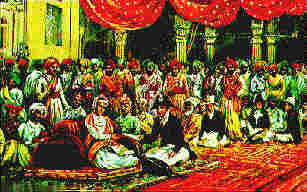 | The Peshwa Shrimant Madhav Rao the first, receiving a petition from a representative of the British. Madhav Rao, was the last of the astute Maratha rulers. His rule in the post-Panipat phase consolidated the weakening Maratha power which was to result in the initial Maratha successes against the British at the Battle of Talegaon in 1782 (1st Anglo-Maratha War) and at the Battle of Assaye (2nd Anglo-Maratha War) some years later. |
The Sikhs meanwhile united under the leadership of Maharaja Ranjit Singh and carried on the unfinished task of the Marathas. The Sikh general Jussa Singh Ahluwalia invaded Abdali's kingdom, defeated Abdali ignominiously and captured his capital city of Kabul. The saffron flag (Nishan Saheb) then fluttered over Kabul after a gap of 800 years after Raja Jaya Pal Shahi lost the city to Sabuktagin in 980 C.E.
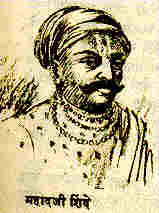 | Mahadji Shinde was the most successful Maratha General of the post-Panipat phase. He not only overcame the Rohillas under Najib Khan and the Nawab of Oudh, but even the Mughal Emperor became a pensioner of Mahadji and received an annual pension from him. Mahadji collected Chauth from all over North India in the period 1761 to 1790. He even checkmated the British who had to concede dominion over north India to him under the Treaty of Salbai. |
Mahadji Shinde
Meanwhile in India proper, in the period between 1761 and 1790, the Maratha power was consolidated by Mahadji Shinde, Nana Phadnavis and Shrimant Madhav Rao Peshwa. Mahadji Shinde took initiative in military matters and he successfully checked the British in the first Anglo-Maratha war. Later of course, the Marathas were to succcumb to the British in after the third Anglo-Maratha war of 1817.
 | Nana Phadnavis was machiavellian minister of the Peshwa Shrimant Madhav Rao. He played a crucial role in the defeat of the British in the first Anglo-Maratha War at Talegaon 1782 that resulted in the Treaty of Salbai between the Marathas and the British. |
Maratha Rule did not Change the Feudal Relations of Production and Distribution
But as far as changing the feudal economic relations were concerned, the Maratha rule did nothing. The feudal relations remained intact. Politically speaking too, the Maratha intermission from around 1720 to 1790 was too brief a period and though the writ of the Marathas ran in the whole of western India with parts of the north and south under their domination they could not bring the entire country uniformly under their rule. And in those parts of the country they ruled, the feudal relations did not undergo any fundamental change apart from the abolition of the Jazia penal tax levied on the Hindus by the Muslim rulers and general freedom from religious persecution of petty Muslim chieftains and representative of the Muslim monarchy based at Delhi.
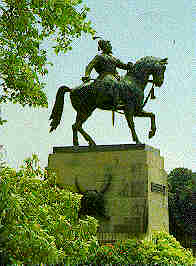 | The Statue of Chattrapati Shivaji Maharaj at Shivaji Park in Mumbai. The spirit of Shivaji Maharaj continues to motivate the people even today. |
In other respects the change of rulership from the Muslims to the Marathas did not represent a departure from the feudal relations of production and distribution The next stage in socio-economic development and new forms of landed property came about with the decline of feudal relations and the medium which brought this about was British colonialism.
_________________________________________
Now we move on to examine the period which marks the beginning of British Rule that also marked the beginning of the current period in Indian History.
_____________________________________________________________
_____________________________________________________________________________________
|
|
_ _ _ |
View My Guestbook
|
_______________________________________
_________________________________
